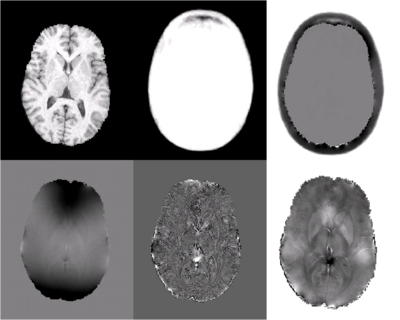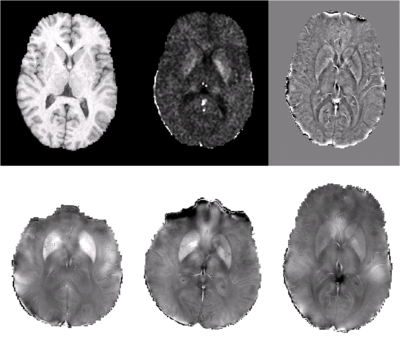Difference between revisions of "Projects:QuantitativeSusceptibilityMapping"
| Line 102: | Line 102: | ||
{| | {| | ||
| − | |[[File:Fig3 elderly compound.png| | + | |[[File:Fig3 elderly compound.png|800px|thumb|alt text]] |
|} | |} | ||
Revision as of 22:11, 24 March 2011
Home < Projects:QuantitativeSusceptibilityMappingQuantifying magnetic susceptibility in the brain from the phase of the MR signal provides a non-invasive means for measuring the accumulation of iron believed to occur with aging and neurodegenerative disease. Phase observations from local susceptibility distributions, however, are corrupted by external biasfields, which may be identical to the sources of interest. Furthermore, limited observations of the phase makes the inversion ill-posed. We describe a variational approach to susceptibility estimation that incorporates a tissue-air atlas to resolve ambiguity in the forward model, while eliminating additional biasfields through application of the Laplacian. Results show qualitative improvement over two methods commonly used to infer underlying susceptibility values, and quantitative susceptibility estimates show better correlation with postmortem iron concentrations than competing methods.
Description
There is increasing evidence that excessive iron deposition in specific regions of the brain is associated with neurodegenerative disorders such as Alzheimer's and Parkinson's disease [1]. The role of iron in the pathogenesis of these diseases remains unknown and is difficult to determine without a non-invasive method to quantify its concentration in-vivo. Since iron is a ferromagnetic substance, changes in iron concentration result in local changes in the magnetic susceptibility of tissue. In magnetic resonance imaging (MRI) experiments, differences in magnetic susceptibility cause perturbations in the local magnetic field, which can be computed from the phase of the MR signal.
The field perturbations caused by magnetic susceptibility differences can be
modeled as the convolution of a dipole-like kernel with the spatial susceptibility
distribution. In the Fourier domain, the kernel exhibits zeros at the magic angle,
preventing direct inversion of the fieldmap [3]. Critically, limited observations of
the field make the problem ill-posed. The observed data is also corrupted by
confounding biasfields (ie. those from tissue-air interfaces, mis-set shims, and other
non-local sources). Eliminating these fields is critical for accurate susceptibility
estimation since they corrupt the phase contributions from local susceptibility
sources.
In general, methods that rely heavily on agreement between observed and
predicted field values computed using kernel-based forward models [2, 3, 6] are
inherently limited since they cannot distinguish between low frequency biasfields
and susceptibility distributions that are eigenfunctions of the model. Examples
of such distributions include constant, linear, and quadratic functions of
susceptibility along the main field (ie. 'z') direction. Applying the forward model to
these distributions results in predicted fields that are proportional to the local
susceptibility sources, but also identical in form to non-local biasfields (ie. those
produced by a z-shim). Therefore, removing all low frequency fields prior to
susceptibility estimation will eliminate the biasfield as well as fields due to the
sources of interest, potentially preventing accurate calculation of the underlying
susceptibility values. In contrast, inadequate removal of the biasfield may result
in the estimation of artifactual susceptibility eigenfunctions in areas where the
biasfield is strong, such as regions adjacent to tissue-air interfaces. This suggests
that additional information such as boundary conditions or priors may be necessary to
regularize an incomplete forward model and prevent the mis-estimation
of low frequency biasfields.
We present a variational approach for Atlas-based Susceptibility Mapping
(ASM) that performs simultaneous susceptibility estimation and biasfield
removal using the Laplacian operator and a tissue-air susceptibility atlas. In [7,
8, 6] it was shown that applying the Laplacian to the observed field eliminates
non-local biasfields due to mis-set shims and remote susceptibility
distributions (ie. the neck/chest).
In this method, large deviations from the susceptibility atlas are penalized,
discouraging the estimation of artifactual susceptibility eigenfunctions in regions near
tissue-air boundaries where the Laplacian may not be sufficient to eliminate the
contribution of non-local sources and substantial signal loss corrupts the observed field.
Agreement of predicted and observed fields
within the brain is also enforced, but deviations in estimated susceptibility values outside the
brain are not penalized, allowing values at the boundary to vary from
the atlas-based prior to account for unmodeled external field sources (ie. shims).
Results


